Have you ever heard of Pink Indian Peafowl? These are the stunning birds that have pink-colored plumage and a long, elegant tail. They are said to be a rare and exotic variety of the Indian peafowl, which is the national bird of India.
But are they real or just a figment of imagination? This is the question that has puzzled many people for a long time. Some people claim that they have seen these birds in the wild, while others dismiss them as a hoax or a legend.
In this article, we will try to answer this question once and for all. We will explore the facts and myths about these mysterious birds, and reveal the truth behind their existence. We will also learn more about the different types of peafowl, their colors, and their characteristics. By the end of this article, you will have a clear picture of whether Pink Indian Peafowl are a reality or a fantasy.
Pink Indian Peafowl: A Rare Phenomenon
If you’ve ever heard rumors of a pink peacock, you may be wondering if they really exist. While there is no record of a real pink peacock, there are different color peacocks that can be found in nature. The most common color of peafowl is the Indian Blue, which features a vibrant blue and green plumage. However, there are other varieties of peafowl species, such as the white peafowl and the red peacock, that showcase different colored feathers.
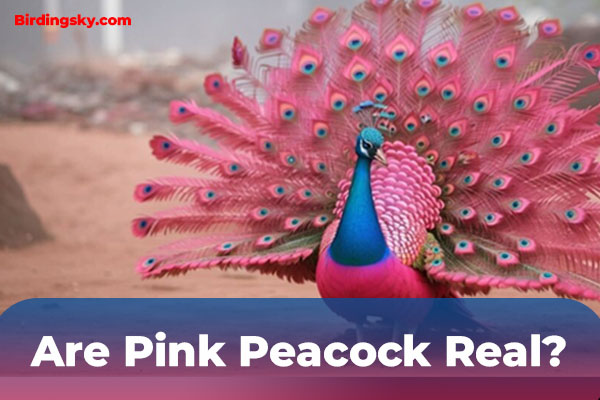
The plumage of a peacock is one of the most stunning sights in the world of birds. Their feathers, also called tail coverts, are long and iridescent with striking colors. Peafowls, also known as peafowl species, have unique and colorful plumage that makes them stand out in the animal kingdom. Contrary to popular belief, peahens can also be quite colorful. Female peafowl have feathers with shades of brown and green, which blend in with their natural environment to provide protection from predators.
| Peafowl Species | Colors |
|---|---|
| Indian Blue Peafowl (Pavo cristatus) | Blue, Green |
| Green Peafowl (Pavo muticus) | Green, Bronze, Blue |
| Congo Peafowl (Afropavo congensis) | Blue, Grey, Brown |
Pink peacocks really exist but only as a result of a genetic mutation. Although they are not a separate species of peafowl, there have been cases of individuals with pink-colored feathers in captivity. While these rare individuals are admired for their unique beauty, it is important to note that they are not commonly found in the wild.
Overall, peafowl are fascinating birds that never fail to amaze with their stunning plumage and unique characteristics. If you’re lucky enough to catch a glimpse of one of these birds in the wild, take a moment to appreciate their remarkable beauty.
The Genetics of Pink Indian Peafowl
If you have ever wondered about the possibility of a pink peacock, you might be surprised to learn that genetic mutations can result in unique color variations in these majestic birds. While the Indian Peacock (Pavo cristatus) with its iridescent blue and green plumage, and the Blue Peafowl (Pavo muticus) native to southern England and known for its distinctive green body, are among the most well-known peafowl species, there are several other species with fascinating color variations. These include the Green Peafowl (Pavo muticus), characterized by its iridescent green plumage, and the Congo Peafowl (Afropavo congensis), with its striking blue plumage and white underparts.
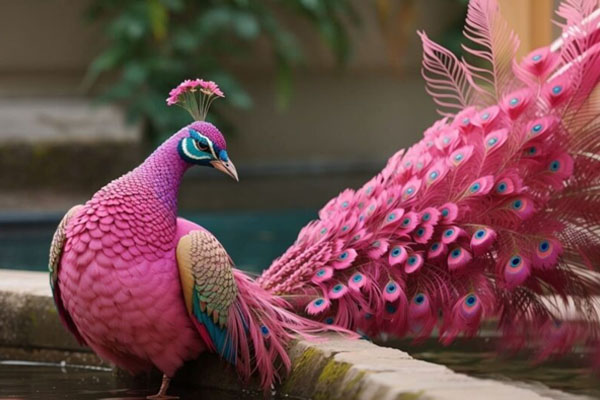
Peacock feathers are well-known for their iridescence, fascinating patterns, and soft texture. In particular, the covert feathers, upper tail coverts, and tail feathers of male Green Peafowl are highly prized among collectors and enthusiasts. And while female peacocks tend to have less elaborate plumage than males, they still display stunning colors and feather patterns that are unique to their species.
| Peafowl Species | Characteristics |
|---|---|
| Indian Peacock (Pavo cristatus) | Male with iridescent blue and green plumage |
| Blue Peafowl (Pavo muticus) | Native to southern England, males have
green body with blue head and neck |
| Green Peafowl (Pavo muticus) | Male with iridescent green plumage, female
with brown and cream plumage |
| Congo Peafowl (Afropavo congensis) | Males have striking blue plumage and
white underparts, females have brown and cream plumage |
Despite their stunning colors, it is important to note that the possibility of a genuine pink peacock remains a mystery. While there have been reports of sightings of pink peafowl, these claims are often disputed and may be the result of lighting or other factors. However, mutations have been observed in Indian Peacock populations that result in slight color variations, such as white and brown feathers. These mutations can occur naturally or through selective breeding, and can result in alterations to the feather coloration or patterns of male and female peafowl.
With their unique genetics and stunning iridescent plumage, peafowl continue to fascinate researchers and enthusiasts alike. Whether you are interested in the different colors and patterns of peacock feathers, or simply enjoy the loud call and courtship displays of these beautiful birds, there is always something new to discover.
The Significance of Pink Peafowl in Indian Culture and Beyond
Peafowl hold a special place in Indian culture, where they are revered and admired for their stunning beauty and distinctive calls. In fact, the Indian Peafowl (Pavo cristatus) is the national bird of India, held in high esteem since ancient times. The bird’s striking appearance and colorful plumage have been the subject of art, literature, and folklore for centuries.
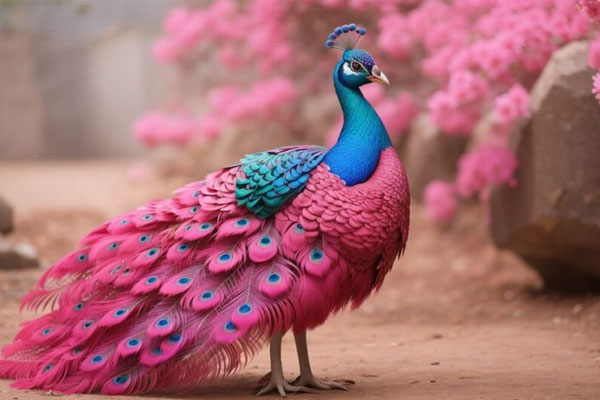
In addition to India, peafowl are also found in other parts of the world, such as Sri Lanka and the Congo Basin. The Green Peafowl (Pavo muticus) is native to Southeast Asia and is known for its metallic green plumage, while the Congo Peafowl (Afropavo congensis) is found in the forests of central Africa and has a distinctive blue facial skin.
Peafowl are dimorphic, meaning that males and females have different physical characteristics. Male peafowl, also known as peacocks, are known for their vibrant plumage, which includes iridescent blue and green feathers. In contrast, female peafowl, known as peahens, have muted brown feathers that provide camouflage when nesting.
| Fact | Detail |
|---|---|
| National Bird of India | The Indian Peafowl (Pavo cristatus) holds |
| Other Countries | Peafowl are also found in Sri Lanka and
the Congo Basin. |
| Pink Peafowl | There have been sightings of bright pink peafowl,
though they are rare, and the cause of their unique coloring is the subject of much speculation. |
| Distinction Between Male and Female | Male peafowl, or peacocks, are known for their
iridescent blue and green plumage, while female peafowl, or peahens, have muted brown feathers. |
Peafowl play a significant role in mythologies and popular cultures across the world. They are often associated with beauty, strength, and grace, and their feathers have been used for decorative purposes in fashion and accessories. In Hinduism, the peacock is believed to symbolize compassion, patience, and immortality, while in Christianity, the bird is associated with resurrection and renewal.
With their striking appearance and rich history, it is no wonder that peafowl continue to captivate people’s imaginations. If you have the opportunity to encounter peafowl in person, be sure to take a moment to appreciate their beauty and grace.
Pink Indian Peafowl: Fact or Fiction?
If you’re a peafowl enthusiast, you may have heard rumors of the elusive pink peafowl. Some claim to have seen these rare creatures with their own eyes, while others dismiss the idea as mere fiction. So, which is it?
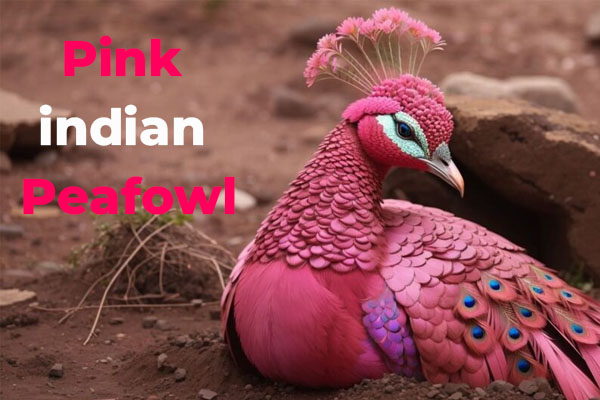
Let’s examine the evidence. Firstly, it’s important to note that male peafowl, also known as peacocks, come in a variety of colors ranging from blue and green to the more common Indian blue with white tail feathers. While pink feathers are not typically associated with peafowl, they are not impossible.
There have been sightings of peafowl with pink feathers, but these sightings have been rare. Some speculate that a genetic mutation may be responsible for this unique color variation, while others believe that it may be a result of environmental factors such as a pink background reflecting onto the bird’s feathers.
| Characteristic | Description |
|---|---|
| Tail Coverts | Peahens prefer peacocks with more elaborate tail coverts. |
| Elaborate Trains | Peahens also prefer peacocks with more elaborate trains,
which may be more attractive to potential mates. |
| Male Peafowl | Male peafowl are known for their stunning beauty and
are often used as a symbol of royalty or luxury. |
| Indian Subcontinent | The Indian subcontinent is home to several
species of peafowl, including the Indian blue peafowl and the green peafowl. |
| Common Peafowl | The common peafowl, also known as Indian peafowl,
is the most well-known species of peafowl. |
| Male Peafowl | The male peafowl is known for its iridescent blue and green plumage. |
| Green Peacock | The green peacock is a species of peafowl native to Southeast Asia. |
Whether or not pink peafowl actually exist remains a topic of debate. However, it’s clear that these stunning birds have captured our imagination with their beauty and unique characteristics.
So, the next time you see a male peafowl flaunting his elaborate train of feathers or hear the loud call of these majestic birds, remember the mystery and allure that surrounds them. Who knows, you may just catch a glimpse of a pink peafowl someday!
Research and Observations
Scientific research and observations have uncovered fascinating insights into the peafowl species. The possibility of a pink peacock is a result of a genetic mutation that occurs naturally in these birds. While there is no definitive evidence of a pink peacock in the wild, observations have been made of a male green peafowl with blue and green plumage that may have inspired the idea of a pink peacock.
Indian peafowls, which are known for their distinctive blue and green plumage, are the most common peafowl species. However, other species, such as the golden peacock, a bird with pink feathers, and the green peafowl, can also be found in the wild. These birds are typically found in Asia and Africa and are known for their iridescent colors and elaborate tail coverts.
| Peafowl Species | Habitat | Features |
|---|---|---|
| Indian peafowl (Pavo cristatus) | Indian subcontinent | Blue and green plumage |
| Green peafowl (Pavo muticus) | Southern and Southeast Asia | Iridescent colors and
elaborate tail coverts |
| Congo peafowl (Afropavo congensis) | Congo Basin | Dark brown feathers and
white upper tail coverts |
Peafowl are also commonly found in captivity, where their beauty and unique characteristics have earned them a place in many zoos and bird parks around the world. Studies have been conducted on both wild and captive peafowl to better understand their behavior, mating habits, and vocalizations.
Overall, the study and observation of peafowl have provided invaluable insights into these stunning birds and their unique characteristics. Whether in the wild or in captivity, watching these birds display their beautiful plumage is a sight to behold.
The Call of the Peafowl
If you ever heard a loud call that resonates in the air, it could be the unique vocalizations of peafowl. Native to the Indian subcontinent, peafowl communicate with their loud calls, using unique vocalizations to attract potential mates or as a warning sign of danger.
Peafowl have covert feathers, which are designed uniquely to reflect light and create a shimmering effect, adding to their visual appeal. Unlike Indian peafowl, green peafowl have a lower vocal range, producing a deep, throaty sound, while the Indian peafowl’s voice is shriller and more piercing.
Peafowl also have distinctive upper tail coverts, which they use to create fan-like displays during courtship rituals. The Indian peafowl has long upper tail coverts with distinctive eye-like spots. Mutations of Indian peafowl have also been observed, resulting in various color variations in their feathers.
During courtship displays, male peafowl will spread their feathers to reveal their dazzling plumage. Peahens prefer peacocks with more elaborate trains, which is often associated with higher quality, genetic traits. This makes their courtship rituals unique and highly impressive to observe.
Peafowl in the Wild and in Captivity
Peafowl, the magnificent birds with vibrant plumage, are found in both wild and captive environments. A population of feral peafowl can be found in different regions, including the United States, Australia, and the UK, exhibiting their natural behavior patterns.
In the Whipsnade Wildlife Park in the UK, peafowl are bred in captivity with over 60 birds on the grounds. A Japanese study conducted on free-ranging peafowl found that peafowl do not select mates based on their plumage; instead, female peafowl do not select mates at all.
There are three species of peafowl: the Indian peafowl (Pavo cristatus), the Green peafowl (Pavo muticus), and the Congo peafowl (Afropavo congensis). While peafowl are bred for their elaborate plumage, studies show that peafowl do not select mates based on their feathers’ brilliance, ruling out popular beliefs on courtship preferences.
Myths and Legends Surrounding Peafowl
Peafowl have been captivating humans for centuries with their stunning beauty and unique characteristics. Throughout history, these captivating creatures have been a source of inspiration for various legends and myths. One such legend includes the famous Peacock Throne, a legendary seat made for Mughal emperors of India, embellished with precious gems and featuring a peacock’s tail.
| Myth/Legend | Description |
|---|---|
| Feathers of the Peacock | Feathers of the peacock are sometimes thought
to bring good luck and are associated with the Hindu goddess Lakshmi, who represents wealth and prosperity. |
| White Peafowl | The white peafowl is considered sacred in Buddhism
and is thought to represent purity and enlightenment. |
| Indian Blue Peafowl | The Indian Blue Peafowl is believed to be native to India
and is also the national bird of the country. It is often associated with royalty and symbolizes beauty, grace, and pride. |
| Male Indian Peacock | The male Indian peacock is famous for its colorful,
iridescent plumage, which is used during courtship displays to attract females. It is believed that the more elaborate the display, the more attractive the male is to the female. |
| Congo Basin | The Congo Basin is home to the Congo Peafowl,
also known as the African peafowl, which is the most colorful species of peafowl. It has brightly colored feathers and is known for its distinctive blue-green plumage. |
| Peacocks are often seen | Peacocks are frequently found in Hindu and Jain art
and are associated with deities in these religions. |
| Brown Feathers | Brown feathers are sometimes believed to be
a sign of bad luck or misfortune. |
These myths and legends demonstrate the significant cultural and religious significance of peafowl throughout history. Peafowl are not only beautiful creatures, but they also hold a special place in our hearts and imaginations.
Uncovering the Pink Peacock Enigma
Peafowl are known for their striking plumage, with males of some species boasting tail feathers up to six feet long that are adorned with vibrant iridescent hues. But what about the possibility of a pink peacock?
While sightings of these elusive creatures have been reported, there is some speculation as to whether pink peafowl actually exist in the wild. One theory that has been put forth is that pink peafowl are not a distinct species but instead the result of a genetic mutation that affects the color of their feathers.
In addition to pink peafowl, there are a variety of species and color variations of peafowl that exist in the wild. The Burmese peafowl, also known as the “green peacock,” boasts a stunning display of green and bronze plumage, while the United peafowl, a hybrid of Indian and Green peafowl, showcases a unique blend of colors from both species.
| Peafowl Species | Description |
|---|---|
| Indian Peafowl | Known for their vibrant blue and green plumage,
with the male featuring an iridescent crest and long, sweeping tail feathers used in courtship displays. |
| Burmese Peafowl | Distinct for their unique green and bronze plumage
and blue neck feathers, with the male also donning long tail feathers used in courtship displays. |
| United Peafowl | A hybrid species of Indian and Green peafowl,
displaying a unique blend of both species’ colors. |
Peafowl have long been revered for their stunning display of plumage and unique courtship behaviors. During courtship displays, males will use their long and colorful tail feathers to attract females and establish dominance over other males.
While peafowl have been observed in a variety of regions, including the Indian subcontinent and the Congo, they are not without their predators. Cobras have been known to prey upon peafowl, as have other birds of prey and ground-based predators.
In conclusion, while the existence of pink peafowl in the wild may still be up for debate, there is no shortage of stunning and unique species and color variations of peafowl to admire and appreciate.
Exploring the Natural and Captive World of Peafowl
If you are a peafowl enthusiast, you would be delighted to know that these beautiful birds are found all over the world. From their native lands in India and Sri Lanka to exotic locations like the United States and Australia, these birds are truly a gift to nature.
Peafowl are often seen as a symbol of grace, beauty, and prosperity, and have been introduced to many other countries around the world. The creamy white plumage of peafowl adds to their charms, and they are often referred to colloquially as the most elegant birds in the world.
The symbolic significance of these birds has led to their capture and placement in zoos and wildlife parks all over the world, where visitors can observe and admire them. One such park is Jurong Bird Park in Singapore, which is home to several species of peafowl, including Indian peafowl and green peafowl.
| Location | Population |
|---|---|
| Lahore Zoo, Pakistan | Over 100 peafowl, including Indian Blue and White Peafowl |
| San Diego Zoo, USA | Over 30 peafowl, including Indian Blue Peafowl |
| Chester Zoo, UK | Several peafowl, including Indian Blue and Green Peafowl |
Peafowl are also present in the wild, where their behavior and actions provide researchers with valuable insights. A Japanese study of free-ranging peafowl found that female peafowl do not select mates based on the length of a male’s tail feathers, as is commonly believed. Instead, they prefer peacocks with more elaborate courtship displays.
In conclusion, whether you are in search of peafowl in their natural habitats or wish to observe them in captivity, there are plenty of options to explore. These elegant and graceful birds will continue to captivate and charm people all over the world with their beauty and mythos.
Unveiling the Truth: Where to Find Different Color Peafowl
If you are a peafowl enthusiast looking to catch a glimpse of different color peafowl in their natural habitat, then you’re in the right place! In this section, we will explore the world of peafowls, including the Indian peafowl, green peafowl, and congo peafowl. Let’s discover their preferences and habitats, and where you can find them.
Pink Indian Peafowl (Pavo Cristatus)
The Indian peafowl or the peacock is a male bird with a colorful blue and green plumage. In contrast, the peahen or female does not have eye-catching feathers and is often mistaken for different species of brown birds. Peafowl are native to the Indian subcontinent and can be found in the gardens, farms, and forests of India, Sri Lanka, and neighboring countries. You can spot them in national parks such as Jim Corbett, Kanha, and Ranthambore.
Green Peafowl (Pavo Muticus)
The green peafowl or the green peacock is native to Southeast Asia and is often found in the dense forests of Indonesia, Thailand, and Myanmar.
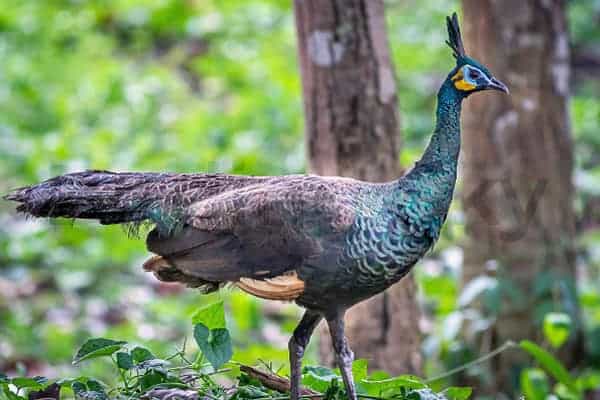
This species is larger in size than the Indian peafowl and is known for its vibrant green, metallic blue, and gold plumage. You can witness them in the natural habitat at the Khao Yai National Park and Kaeng Krachan National Park in Thailand.
Congo Peafowl (Afropavo Congensis)
The Congo peafowl or the African peacock is found in the Congo Basin of Central Africa.
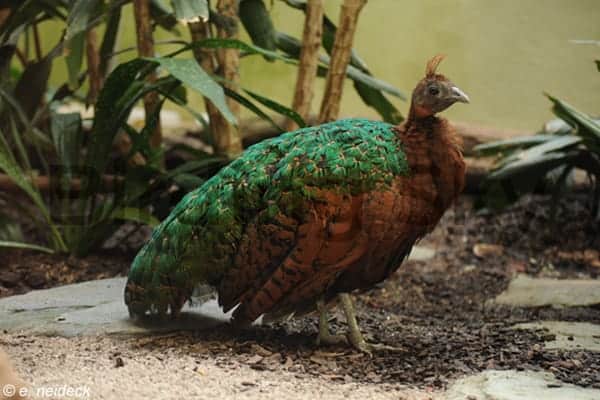
This is a beautiful bird with a rich blue plumage and distinctive facial features, including a red face, yellow patches around the eyes, and a white chin. You can spot them in the Nouabalé-Ndoki National Park in the Republic of Congo.
Can there be Real Pink Peacock?
Although there have been reports of pink peafowl, there is no such species as a real pink peacock. Some believe that the existence of pink peafowl could be the result of genetic mutations or crossbreeding. However, such claims have not been scientifically proven as of yet.
Peacock: Male or Female?
The peacock is the male bird of the peafowl species, while the peahen is the female. The peacock is known for its striking plumage of colorful feathers, while the peahen has more subtle plumage and is often brown in color. The role of the peacock is to display its feathers to attract a mate, while the peahen selects the mate based on specific traits and characteristics.
| Species | Preferred Habitat | Special Features | Regions |
|---|---|---|---|
| Indian Peafowl | Gardens, Forests | Blue and Green Plumage | Indian Subcontinent |
| Green Peafowl | Dense Forests | Vibrant Green, Metallic Blue | Thailand, Indonesia |
| Congo Peafowl | Conco Basin | Rich Blue Plumage, Red Face, White Chin | Central Africa |
So pack your bags and head out to these beautiful locations to catch a glimpse of the stunning peafowls in their natural habitat. You never know when you might spot one!
A Glimpse of Peafowl in Captivity
Peafowl’s significance in different cultures and religions has made them an attractive choice for captivity. Keeping them has become popular in many countries due to their stunning beauty and unique characteristics.
In Islam, peacocks hold great significance and are considered sacred birds. According to Islamic mythology, peacock feathers embellish the throne of Prophet King Solomon. Similarly, in Hinduism, peacocks are revered as the national bird of India, and they hold significant importance in their culture and mythology. Buddhists view peacocks as a symbol of self-compassion and spiritual awakening, whereas Christianity portrays them as symbols of rebirth and resurrection.
Peafowl are also highly esteemed in Chinese mythology, where they are known to symbolize divinity, beauty, and yin-yang. Native American tribes believe that peafowl feathers possess healing properties and use them in various ceremonies and rituals. African folklore views peafowl as creatures of protection and guardianship.
To observe peafowl in captivity, there are several places to visit. At the Lahore Zoo, visitors can witness the natural beauty and vibrancy of the Indian blue peafowl. The Jurong Bird Park in Singapore offers a unique and diverse collection of peafowl, including the green peafowl and the Burmese peafowl. The San Diego Zoo in California also has a large population of peafowl that can be observed in their natural habitats.
Table: Peafowl Significance in Different Cultures and Religions
| Culture/Religion | Significance of Peafowl |
|---|---|
| Islam | Sacred bird and embellished the throne of Prophet King Solomon |
| Hinduism | National bird of India and revered in culture and mythology |
| Buddhism | Symbol of self-compassion and spiritual awakening |
| Christianity | Symbol of rebirth and resurrection |
| Chinese Mythology | Symbol of divinity, beauty, and yin-yang |
| Native American Traditions | Creature of protection and guardianship |
| African Folklore | Possesses healing properties and is used in ceremonies and rituals |
Must-Visit Locations for Peafowl Enthusiasts
Are you a peafowl enthusiast eager to witness these majestic creatures in their natural habitat? Look no further than these top locations!
Jurong Bird Park
Located in Singapore, the Jurong Bird Park is home to over 2000 birds, including various species of peafowl. Admire the peacock’s plumage as you explore the lush, exotic landscapes of this renowned park.
San Diego Zoo
If you’re looking to witness a colorful display of peafowl, head to the San Diego Zoo in California, USA. The zoo has a diverse population of peafowl, including the Indian peafowl, green peafowl, and white peafowl, all in their natural glory.
Lahore Zoo
For a unique and immersive peafowl experience, visit the Lahore Zoo in Pakistan. This zoo is home to a large number of peafowl, including the Indian blue peafowl and the Burmese peafowl, surrounded by lush greenery and gardens.
Exotic Locations for Nature Lovers
If you’re looking to explore more exotic locations to see peafowl in their natural glory, consider visiting India, Sri Lanka, or the Congo Basin in Africa. These regions are home to a variety of peafowl species, including the Congo peafowl and the Indian blue peafowl. Marvel at the unique plumage, vivid colors, and courtship displays of these magnificent birds in their natural habitats.
Uncovering the Truth Behind Pink Indian Peafowl
Congratulations on reaching the final section of our article! We hope you enjoyed the journey of exploring the world of peafowl and uncovering the truth behind the elusive pink Indian peafowl.
Throughout this article, we have explored the existence and rarity of pink peafowl, the genetic factors that contribute to unique color variations, and the significance of peafowl in different cultures and traditions. We have also examined the evidence and theories surrounding the pink peacock enigma and provided insights into the behavior and habitats of peafowl in captivity and the wild.
So, what is the truth behind pink Indian peafowl? While there is evidence of genetic mutations in peafowl that can result in unique color variations, there is no definitive proof of the existence of true pink peafowl. However, the possibility of finding pink peafowl in the wild or captivity cannot be completely ruled out.
We hope this article has provided you with valuable insights into the world of peafowl and helped unveil the truth behind the pink Indian peafowl mystery. Remember to visit our recommended must-visit locations to see these beautiful birds in their natural glory. Thank you for reading, and we hope to see you soon!
Wrapping Up…
So, there you have it – the truth behind whether pink Indian peafowl are real or not. While the existence of true pink peafowl remains a mystery, we have explored the various colors and species of peafowl, the genetic factors involved, and the cultural significance of these beautiful birds. We hope this article has been informative and enjoyable for you. Keep exploring the fascinating world of peafowl!
FAQ’s About Pink Indian Peafowl
Q1: What is the rarest peacock color?
The rarest peacock color is white.
Q2: How many colors of Pink Indian Peafowl (peacocks) are there?
Peacocks are known for their vibrant plumage, which includes a variety of colors. The main colors are blue, green, gold, and white.
Q3: Is the Indian peafowl the same as a peacock?
The Indian peafowl is commonly referred to as a peacock. However, “peacock” technically refers to the male, while the female is called a peahen, and together they are called peafowl.
Q4: What is the difference between Congo peafowl and Indian peafowl?
The Congo peafowl and Indian peafowl differ in species and habitat. The Indian peafowl (Pavo cristatus) is native to South Asia, while the Congo peafowl (Afropavo congensis) is found in Central Africa. They also have distinct physical characteristics.
Q5: What are the 15 colors of peacock?
The peacock’s colors include various shades of blue, green, gold, and white. While there may not be exactly 15 distinct colors, the combination and variation of these hues create the peacock’s stunning plumage.
Q6: How rare is a white female peacock?
White female peacocks are relatively rare but not as uncommon as their male counterparts. White peafowls are a color variation resulting from genetic factors.
Q7: Is there a purple peacock?
Peacocks do not have purple feathers in a literal sense. However, the iridescent quality of their plumage can create optical illusions, making some feathers appear to have a purple hue under certain lighting conditions.
Q8: Which peacock is most colorful?
The Indian peafowl (peacock) is often considered the most colorful, showcasing vibrant hues of blue, green, and gold in its plumage. The combination of these colors, along with the striking patterns, makes it a visually stunning bird.
